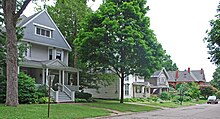Marshall, Michigan
Marshall is best known for its cross-section of 19th- and early 20th-century architecture and as the future home of Ford Motor Company's BlueOval Battery Park.
[6] It has been referred to by the keeper of the National Register of Historic Places as a "virtual textbook of 19th-Century American architecture."
The early settlers named the community in honor of Chief Justice of the United States John Marshall from Virginia—whom they greatly admired.
When escaped slave Adam Crosswhite fled Kentucky and settled in Marshall with his wife and three children, the people of the town hid him from the posse sent to retrieve him.
[10] On the morning of January 26, 1847, as the slave catchers and a local deputy sheriff were pounding on Adam's door, his neighbors heard the noise and came running.
Finally, the deputy sheriff, swayed by the crowd's opinion, decided he should arrest the men from Kentucky instead.
By the time the slave catchers could post bond and get out of jail, Isaac Jacobs, the hostler at the Marshall House, had hired a covered wagon and driven the Crosswhites to Jackson where they boarded a train to Detroit and then crossed over into Canada.
At the conclusion of the second trial, the sole remaining defendant in the case, local banker Charles T. Gorham, was ordered to pay the value of the slaves plus court costs.
[12] To curry political favor, Detroit entrepreneur Zachariah Chandler supposedly stepped in to pay these costs on Gorham's behalf.
John D. Pierce and lawyer Isaac E. Crary, innovated the Michigan school system and established it as part of the state constitution.
A replica of the city's roundhouse can be seen at the Greenfield Village outdoor living history museum in Dearborn, Michigan.
The event received national attention as it was, at that time, the largest oil spill in the inside the United States.
In 2012, the U.S. National Transportation Safety Board stated the Enbridge oil spill in the Kalamazoo River near Marshall was the costliest onshore cleanup in U.S.
[15] In 1968, a large tract of land in Marshall Township, approximately 800 acres, was rezoned to D-2 Park Industrial.
Gerholtz, a former president of the United States Chamber of Commerce, chose the property because of 4 advantages: 1) proximity to the I-94 & I-69 interchange, 2) access to the railroad, 3) access to hard surface road open to industrial truck travel year-round, and 4) proximity to the Kalamazoo River.
In January 1997 the Gerholtz property was recognized by the Marshall Chamber of Commerce as having "statewide and national attention as one of the best locations in Michigan for large scale industrial development.
A lack of short-term site readiness for construction caused Volkswagen to shift attention to other potential development.
Notices were not sent to Marshall Township residents immediately adjacent to on in close proximity to the project.
At the time the proposed development area encompassed up to 1,600 acres of rural land (owned by separate landowners and just under 800 acres of which had previously been zoned D-2 Park Industrial) located in Marshall Township just outside Marshall's city limits.
The Marshall City Council voted for the transfer as well, although there was significant public opposition to the project.
Brooks Field is a non-towered General Aviation airfield owned and operated by the city of Marshall.
The airport features a single runway (10/28) 3500 x 75 feet, helipad, public and private hangars, lighted wind indicator, segmented circle, compass rose, and a tie down apron.



